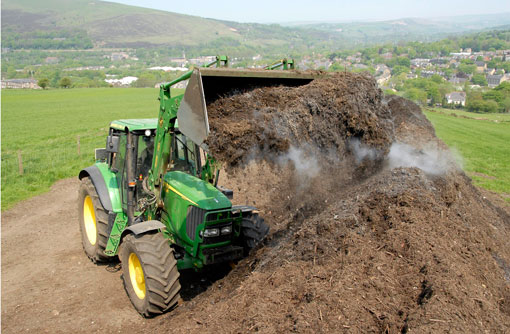Green waste compost helps boost soil health

The benefits of applying green waste compost across a range of soil types are clear to see for one Northamptonshire farming business, as Louise Impey discovered.
The challenge facing most UK arable units has been tackled head on by the Humphrey family following a decision to try and improve both soil structure and condition with the use of compost.
Back in 2002, the business started taking green waste from the local council to produce compost, and has been using the end product across the 610ha farm at Helmdon, near Brackley, ever since.
With a predominantly wheat/rape rotation on heavy clay soils, Mervyn Humphrey’s initial aim was to increase the soil organic matter content to improve both the workability and the surface drainage of his fields.
But, with the passage of time, the improvements have gone further than that. Nitrogen fertiliser applications have been reduced by as much as half on some fields, without loss of yield, and Mr Humphrey has been able to move away from a plough-based cultivation system due to the more open soil structure.
“There are long-term benefits from applying compost,” he says. “At the beginning, we were aiming to build up the soil organic matter content and improve porosity, so that we could travel across the fields more easily, avoiding compaction and water logging.”
Being able to work the soils at key times was another requirement, so that crops could be established in optimum conditions. “The workability benefits have taken a few years to develop, but they have made a big difference. We’re using two fewer passes to create a seed-bed than we were,” he comments.
The compost is applied to stubbles at about 25t/ha, before being worked in, he explains. “We find that the finger-sized pieces of woody material help to keep the clay soils open and improve drainage. The soil is more porous, both on and below the surface.”
As a result, after a heavy downpour, it can now hold 50-75mm of rain, rather than just 25mm. “It has prevented surface puddling, which has helped with other aspects of crop management, such as herbicide uptake and even crop growth.”
Earthworm activity, one of the key indicators of soil health, has increased three-fold. Measurements done by Mr Humphrey’s agronomist, Andrew Richards of Masstock, have shown 17 earthworms per spade full of soil where compost has been applied, compared to just five where there has been no compost.
Mr Humphrey admits that the bulky nature of compost does have its spreading challenges, especially in a wet year. “It can be expensive to spread and it does create more traffic movements at harvest time. In a very wet autumn, we think twice about applying compost.”
In addition, the application window can be tight, so he has a greater area of winter oilseed rape in the rotation to allow the operation to take place, he adds. “It has to be worked in. If we try to apply compost after cereals where we have chopped the straw and the compost is spread on top of it, the task can be quite onerous. Getting it consolidated can mean rolling two or three times.”
The compost costs £25-30/ha to haul and spread, he says. “Controlling the amount of plastic in it is the biggest headache. Technology is improving and vacuums are being used on screening machines at the composting plant, but you have to accept that you will see some plastic on the land.”
Mr Humphrey’s nephew, Mark, who farms near Buckingham on light, sandy soils, also makes good use of compost. He has been able to improve the water holding capacity of the soil, preventing the land from drying out too quickly and reducing the effects of drought.
“Wheat yields got up to 10t/ha this year, despite the very dry spring,” he remarks. “And thanks to the nutrient content of the compost, we were able to use just 150kg/ha of nitrogen on a milling variety and still meet the grain protein specification.”
What is green waste compost?
Green waste from gardens and landscaping, as well as chipped wood, straw, paper/card, waste fruit and vegetables are all included in the compost used by the Humphreys.
The nutrient content varies according to the materials, but typically contains significant levels of potash and useful levels of nitrogen, phosphate and sulphur, explains Mr Richards.
“Nitrate Vulnerable Zone requirements are met by analysing each batch of compost to determine its nitrogen content,” he notes. “That is then taken into account when the application rate is calculated.”
Nmin tests are done to work out what will be available to the crop in the spring. “There is often scope to reduce fertiliser applications after an application of compost.”

